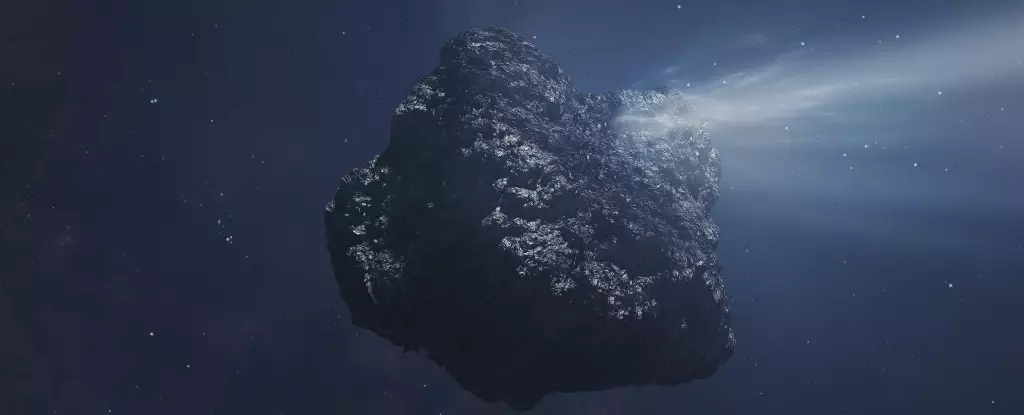The universe has a curious way of sending reminders of its vastness, and the latest revelation in space exploration underscores that very notion. Comet C/2014 UN271, also known as Bernardinelli-Bernstein, is not only a breathtaking sight but a harbinger of the cosmic realities that linger beyond our planet. At a staggering 137 kilometers wide, this enormous comet is a colossal structure—nearly 14 times the size of the asteroid that purportedly wiped out the dinosaurs. Yet, as exciting as this discovery might be for astronomers and enthusiasts, the reality is that a cosmic object of this magnitude hurtling toward us poses questions, some more alarming than others.
More than just a mesmerizing celestial body, UN271 is currently belching out significant amounts of carbon monoxide, an indicator of its volatile inner machinery. This alarming emissions pattern hints at the complexity of the comet’s lifecycle and evolution as it journeys through the Solar System. For scientists, it’s a treasure trove of information; for everyday individuals, it might inspire a mix of awe and anxiety.
Peering into the Abyss: Astronomical Observations
Using advanced tools like the Atacama Large Millimeter/submillimeter Array (ALMA), located in the famed Chilean desert, astronomers have rapidly advanced their understanding of this gargantuan comet. Their observations took place on separate dates, revealing fascinating insights about UN271’s behavior. The initial observation on March 8, 2024, noted a significant outburst, with jets of gas prominently visible. By March 17, however, the comet had seemingly calmed, with only one jet remaining. The fascinating aspect of this observation is not merely the comet’s size, but the section of its lifecycle we’re witnessing—a transient phase that provides clues to its future behavior.
Although previous studies hinted at a quirkier comet personality, this marks the first direct observation of jets and the growing coma, which serves as an atmosphere of dust and gas. The fact that we are observing such phenomena at vast distances—over 16 times farther than the Earth is from the Sun—demonstrates how technology has simultaneously shrunk the universe and magnified our understanding. Yet, it also raises the unsettling question: are we truly prepared to handle the cosmic surprises awaiting us?
The Cosmic Disparity: Beauty and Its Potential Peril
When discussing a massive object like Comet UN271, the implications stretch beyond mere fascination; they illuminate a deeper narrative about human vulnerability in the face of cosmic forces. While freakishly beautiful, the reality of space is an intimidating and chaotic expanse where life on Earth is but a fragile flicker of existence. This comet—almost a harbinger of nature’s raw power—reminds us that the tapestry of life can be shredded by factors far beyond our control.
The contrarian within me acknowledges the allure of such celestial events, yet I cannot help but harbor a sense of foreboding. As we focus on the scientific excitement surrounding incredible discoveries, we must ensure that we don’t lose sight of the essential conversations about planetary defense and preparedness. Optimism should not blind us to the very real potential hazards that exist outside our planet’s atmosphere.
Collective Responsibility: Our Reaction to Cosmic Events
We stand at an intersection, thrust into the public limelight, and faced with decisions concerning our reaction to monumental cosmic happenings like the appearance of UN271. Are we merely passive observers in this grand universal play, or will this event inspire proactive discourse on humanity’s stewardship of Earth and our future in space? Centered in a liberal perspective, I advocate for a nuanced understanding of space exploration that blends awe with action. The exploratory enthusiasm for the cosmos should invigorate discussions on responsible scientific pursuit and the ethical dimensions of space travel.
As UN271 approaches its closest rendezvous with the Sun in January 2031, the key lies in fostering an informed public dialogue. We must encourage the scientific community to reach beyond ivory towers and engage constructively with the public—a relationship built on transparency and accessibility will promote understanding rather than fear.
In contemplating the narrative of Comet UN271, we are not just struck by its sheer scale but also prompted to reconsider our principals and responsibilities. Beautiful and terrifying, this comet challenges us to confront our fragility against the backdrop of a magnificent yet chaotic universe. With such an awe-inspiring sign, the larger question remains: how do we respond?


Leave a Reply